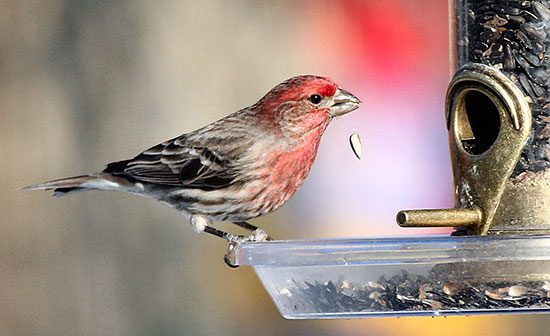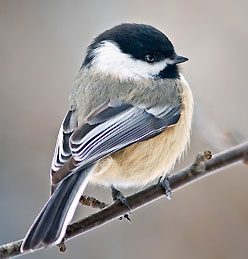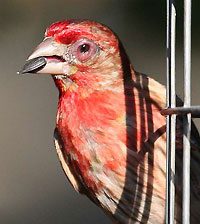Research Surprise: Many Birds Exposed to Eye Disease, but Only Finches Get Sick
By Pat Leonard August 25, 2014
“The results were shocking,” says André Dhondt, director of Bird Population Studies at the Cornell Lab of Ornithology. “More than half the bird species we tested have been exposed to the bacteria responsible for House Finch eye disease.” A paper recently published in the online scientific journal PLOS ONE shows that a bacterial parasite previously thought to infect only a few species of feeder birds actually can infect a wide range of species, though most do not show signs of illness.
“This organism, Mycoplasma gallisepticum, is much more widespread than anyone thought,” Dhondt explains, “although in most species there are no signs of conjunctivitis.”

Species testing positive for exposure to the bacteria include feeder favorites such as Black-capped Chickadees, Tufted Titmice, and American Goldfinches. But exposure was also detected in forest species, such as the Wood Thrush.
“That was another surprise,” says Dhondt. “How on earth do Wood Thrushes get infected with mycoplasma? They’re not a feeder bird at all. Everyone has always assumed that feeders play a major role in the transmission of the disease and this study shows that’s not necessarily so.”
Dhondt’s team caught and tested nearly 2,000 individual birds from 53 species, looking for evidence of current infections (bacterial DNA) or past infections (antibodies) by Mycoplasma gallisepticum. The birds were studied in and around Ithaca, New York, between January 2007 and June 2010. The diagnostic tests revealed that 27 species of birds were infected by this bacterium. The actual number of species exposed to the bacteria could be even higher than suggested by this study because the test for antibodies is known to produce false negatives.
House Finch eye disease first appeared in North America in 1994 when people watching backyard feeders started seeing birds with swollen, runny eyes. Dhondt says that a strain of the bacteria, usually found in poultry, was able to grow successfully in House Finches (see Jumping the Species Barrier). The House Finch lineage of the bacteria has been mutating since it was first detected.
“The organism could mutate into a form that is much more virulent among other bird species and create a new epidemic,” noted Dhondt, who added that while we know that many species of songbirds are exposed to Mycoplasma gallisepticum, we still do not know whether the bacteria in other species of songbirds are identical to that living in House Finches in the same area.

While many species of songbirds can be infected by this bacterium, only House Finches regularly exhibit swollen eyes as a result of infections, and citizen-science participants in the Cornell Lab’s Project FeederWatch are still tracking the occurrence of disease in these finches. The take-home message for people who feed backyard birds remains the same: keep the feeders clean. If you see sick birds, leave them alone, take down the feeders and clean them, and be sure to wash your hands thoroughly afterward.
The paper, Diverse wild bird host range of Mycoplasma gallisepticum in eastern North America, is coauthored by André Dhondt, Jonathan C. DeCoste, and Wesley M. Hochachka from the Cornell Lab of Ornithology, and David H. Ley, North Carolina State University.
The work described in this paper is part of a larger collaborative research project that has received funding from both the NSF and NIH through their Ecology and Evolution of Infectious Diseases Initiative.
For more information about House Finch Eye Disease:

All About Birds
is a free resource
Available for everyone,
funded by donors like you
American Kestrel by Blair Dudeck / Macaulay Library
